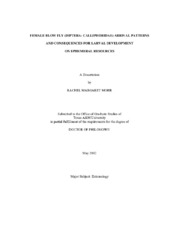| dc.description.abstract | This investigation explored the environmental and physiological factors affecting adult blow fly (Diptera: Calliphoridae) arrival and attendance at pig (Sus scrofa domesticus L.) carcasses in Brazos Co, TX in the summer and winter, and validated a new technique for estimating the pre-colonization interval. It also examined how the offspring of said blow flies compensate for adverse developmental conditions such as starvation or the presence of older competitors by determining the function of minimum viable weight, critical weight, and the terminal growth period in Cochliomyia macellaria (F.) (Diptera: Calliphoridae). Adult blow fly carcass attendance is poorly explained by temperature, wind speed, ambient light intensity, or body size for either winter or summer-active species. Time of day explained approximately 10% in carcass size variation for all four of the most common species. For summer flies, the degree of ovarian development changed significantly from 96%/98% fully developed on day 1 postmortem to 7%/2% fully developed on day 2 postmortem for C. macellaria and Chrysomya rufifacies (Macquart)
iv
respectively. Using the binomial distribution, the minimum postmortem interval was correctly estimated for 4/6 validation tests. Minimum viable weight for C. macellaria was found to be ~ 0.02 g, and was stable under conditions of starvation and simulated competition. Under starvation conditions, time to pupariation was not altered, whereas under simulated competition, growth rate was increased and terminal growth period shortened. Starved flies under simulated competition entered the pupal state ~12 h faster than starved flies without competition, but required ~12 longer to complete development. These effects should be considered when estimating post-colonization intervals. | en |


